Allen Tiller's Blog, page 8
November 5, 2023
Munno Para West District Council Office – 9 Adelaide Road - Hidden Secrets
Munno Para West District Council Office – 9 Adelaide Road - Hidden Secrets.
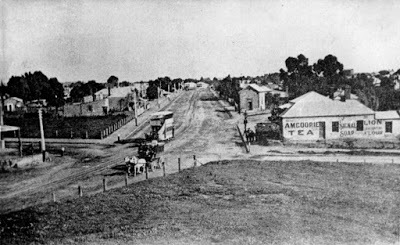
<Transcript>
If you live in Gawler you’ve probably driven past the little building on the corner of Adelaide Road and Twelfth Street a thousand times but never given it a second thought.
Currently, the building is Creative Outdoors Display Centre, previously it has been used as a second-hand store and a tax agent, but none of these were its original purpose.
Bound in the south by the Little Para River, and in the North by the Gawler River, The District Council of Munno Para West Was formed in 1854, a year after the District Council of Munno Para East was formed.
The council included the towns of Virginia, Smithfield, Penfield, Angle Vale, St Kilda and Gawler Blocks. Gawler Blocks were later to be known as Gawler South and removed from the District Council of Munno Para West in 1899.
The District Councils of Munno Para East & West were united to become the City of Munno Para in 1933, with some sections going to the Town of Gawler, and others going to the District Council of Salisbury, the rest were merged with the Munno Para East Council.
The building that stands today was originally built to be a chapel in 1855, however, it was bought in 1861 to become the District Council of Munno Para West’s head office, whilst the District Council of Munno Para’s East office was in Murray Street Gawler – you may recognise it as the building currently next door to Elders.
<End Transcript>
Since publishing this video, I have been informed that this small building was the home of a family of ten during the 1950/60s. It has also been used as a computer store (information supplied by Robby Cummins), a sex toy store, and a second-hand store.
In March 2019, Creative Outdoors ended their lease at the location. It now sits empty awaiting its next use.
In 2021 - the location is now a Real Estate Agent: Raine and Horne
Researched and written by Allen Tiller ©2019
November 4, 2023
Gawler: The Colonial Athens
First shared on ‘Gawler: Colonial Athens’ Blog Monday, 18January 2021.
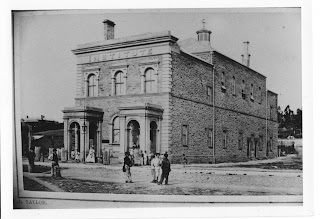
91 Murray Street - Gawler Institute, after 1870 and before 1878
Source: Gawler History Team Inc.
“If ever there wasa go-ahead little spot on the globe's surface, Gawler may lay claim to thatdistinction.” – Traveller c.1870.[1]
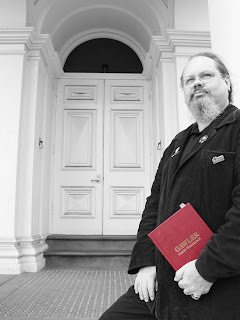 Allen Tiller
Allen TillerPhoto Daniel James Down
Gawler in PhotographsHi, my name is Allen Tiller, I am the author of this blog.
I was born in Gawler at the Hutchinson Hospital. I was educated at theEvanston Primary School and Gawler High School. I moved away from Gawler in the1990s and intermittently lived in Gawler over the decades before moving backto the town in 2016.
You might know me from the television show Haunting: Australia. I havehad an extensive career in the media over the past decade. Before that, Iworked in Warehousing and Distribution here in South Australia, and inQueensland. After Haunting: Australia filmed in 2013 I suffered a seriousinjury and could no longer work in warehousing, so I went to TAFE and retrainedas a Librarian. At the same time, I studied for a Diploma in Family History atthe University of Tasmania. Currently, I am halfway through studying for a degreemajoring in history, also with UTAS.
I am also a published poet and a published historical author. I havewritten tours of local councils and am an Executive Member of the GawlerHistory Team. As well as a parent and grandparent!
I often write on myblog The Haunts of Adelaide about crimes, paranormal and odd history aroundSouth Australia. I also have a blog dedicated only to paranormal themes, TheEidolon Paranormal Blog and one dedicated to Kapunda. I decided this year Imight take some of the copious local history and knowledge of Gawler I have storedand put it out on the interwebs for others to read.
So, I started thisblog!
Why the name“Gawler: Colonial Athens”?
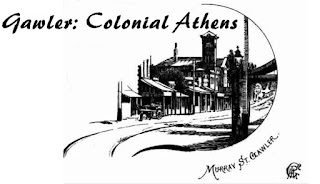
During the 1860s, Gawler had established an Institute, a foundation ofknowledge. Within it is a library. The Institute had supported the arts andeducation. The township also attracted many university-educated Germans whosettled at nearby Buchfelde.
No one knows exactly who phrased the term, but E.H Coombe stated:
“It is the custom of many writers and speakers to refer to Gawleras “the Modern Athens”, presuming this was the title bestowed conferred upon itin the early days by admirers of its literary activities/ The title thenbestowed upon it as a genuine compliment was ‘The Colonial Athens’.
Edinburgh has the distinction of being ‘The Modern Athens’. Gawler secured it’sflattering cognomen of ‘the colonial Athens’ because of its spirited action ofits Institute in connection with the competitions for a Song of Australia and aHistory of South Australia. In referring to this matter the late Mr. E.L.Grundy remarked; ‘no one of the many sensible minds in Gawler would think ofassuming the title of ‘The Colonial Athens’, yet they are willing to hold itand adopt the friendly compliment as being calculated to impart to the youngaround as a wholesome consciousness that they are in a position in the world’seye where mental and moral superiority are looked for…”[2]
So, there you haveit, Gawler was dubbed the ‘Colonial Athens’. Later, Adelaide got in on the actand dubbed itself “The Athens of the South”. As Oscar Wilde said, ‘Imitationis the sincerest form of flattery that mediocrity can pay to greatness.’
This blog willprobably be posted irregularly, as my time permits. There will becross-posts from my other blogs and Gawler-based projects, and links (many links!) to the Gawler History Team Inc. websitegawlerhistory.com.
Hope you enjoyGawler’s History.
Allen Tiller19/01/2021.
UPDATE: Since writing this blog in 2021, I have earned a B.A. in History with First Class Honours at the University of Tasmania. I have also deleted the former Gawler: Colonial Athens' blog and reposted the material here. A.T. - 2023.
[1] "THECOLONIAL ATHENS."', The Register, (30 July 1910), p. 4.
[2] Gawler,Derek Whitelock, (1989), p.79.
Photographs:
Gawler HistoryTeam: https://www.flickr.com/photos/gawler_...
Gawler In Photographs, Daniel James Down,2020: https://www.facebook.com/Gawlerinphot...
Gawler's Hotels
Gawler's HotelsFoundation years of Gawler's Hotels
Golden Fleece 30-10-1839 (Also known as The Old Spot Hotel)
Old Bushman 24-9-1840
Gawler Arms 1848
Willaston Hotel 1849
Kingsford (also known as the Globe Hotel ) 1851
Railway Hotel 1854 (also known as 'The Terminus' & 'Overway Hotel) - currently closed.
South End 1855 (also known as The Southern)
Gawler Belt Inn 1857
Engine and Driver 1858 (21st Street - now a private residence)
Prince Albert 1859
Wheatsheaf 1859-1873 (now Tikka Talian Restaurant.)
Criterion 1864
Exchange 1868
BEANS.
‘Beans', Bunyip, (17 October 1879), p. 2., http://nla.gov.au/nla.news-article972....
This article was published on my Gawler: Colonial Athens blog in 2023. Allen Tiller
November 3, 2023
Kaurna People
'I would like to begin by acknowledging the Kaurna people,Traditional Custodians of the land on which we the Town of Gawler stands todayand pay my respects to their Elders past and present. I extend that respect toAboriginal and Torres Strait Islander peoples here today.'[1]
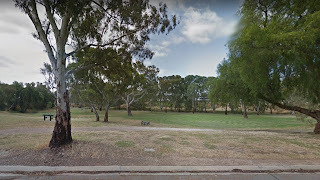
Before European settlement, the area we now identify asGawler was the home to the Kaurna people. The North Para, South Para and GawlerRivers are all sacred sites to the Kaurna mob, as is the junction of the threerivers found at Parridla Taikondi Parank in what is now Lawrence Ave, GawlerSouth.
The name Parridila Taikondi; Parri is a Kaurna word forriver and parridla means rivers. Taikondi is the Kaurna word for comingtogether.[2]
Kaurna Country Map - Click here.
Town of Gawler - Local Aboriginal Culture - Click here.
Researched and written by Allen Tiller © 2021
[1] Welcome to Country or Acknowledgement of Country,Commonwealth of Australia,https://www.indigenous.gov.au/contact....
[2] Significant Local Areas, Town of Gawler, (2020),https://www.gawler.sa.gov.au/about-ga....
[3] Map of IndigenousAustralia, AIATSIS, (2023)m https://aiatsis.gov.au/explore/map-in....
Kapunda Biographies: John Hill
Kapunda Biographies: John Hill(Orignally posted on 'The History of Kapunda' Tuesday, August 7, 2012.)
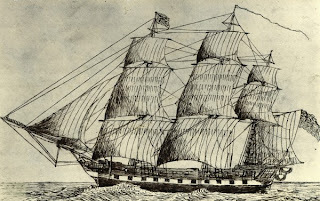
Kapunda, A town of mystery, a town of history, and a town with a past like no other. Today I am starting a new edition to the blog, highlighting some of the people who lived, worked, played, loved and built the town. Some of the ladies and gentlemen I will profile over coming months have long left. Others are living in the town today, you may have passed them in the street and not known what achievements they had accomplished, right here in Kapunda. With this blog, I aim to change that!
To get started, I am going to profile a gentleman who passed away long ago. A man who crossed the sea to play an important role in South Australian history. A man who would eventually call Kapunda home, and be buried in the Clare Road Cemetery.
Mr John Hill served as boatswain (The Foreman of the “unlicensed” crew) in His Majesty, King William's ship, The Buffalo. [1]
John Hill was born on the 3rd of June 1808 in Cheshurst, Hertfordshire, England. Mr Hill was a skilled thatcher before serving his King in the English Navy.
John Hill's most notable mark in South Australian history, other than coming to our fine shores aboard the Buffalo, was under the soon to be Governor of South Australia, Captain John Hindmarsh.
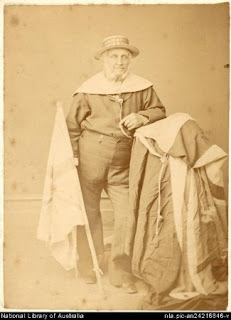
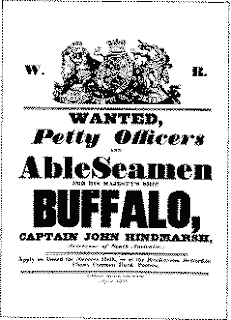 As the proclamation, declaring South Australia a British colony was read aloud to the gathered sailors and dignitaries, John Hill raised the British Flag, thus marking his place in South Australian history for all time. He was aged 29 at the time.
As the proclamation, declaring South Australia a British colony was read aloud to the gathered sailors and dignitaries, John Hill raised the British Flag, thus marking his place in South Australian history for all time. He was aged 29 at the time.Mr Hill was soon engaged in the colony to undertake his regular occupation, thatching rooves for the newly colonised State. The only skilled roof thatcher available, he was very busy and was summoned to thatch the roof of the Governor's house.
Mr Hill died at the age of 77, on the 2nd of April 1885, and was interred in The Clare Road Cemetery.
Mr Hill's wife and family were very proud of the fact that their husband and father hoisted the flag on proclamation day and marked the significance upon his tombstone.
His grave also features a very distinct and different marking. It features as the centrepiece the “British Standard” with Gum tree carved into Headstone.
Mr Hills obituary appears in the South Australian Register on page 2, April 11th 1885 and reads,
Deaths of Pioneers.— Our Kapunda correspondent mentions that bluff, hearty old John Hill the boatswain of the Buffalo, who hoisted the flag at Glenelg when the colony was proclaimed, died on Thursday evening, after an illness of four months. He was 77 years of age, and during his life enjoyed the very best of health until recently, when he was attacked by bronchitis. During his illness, he suffered a great deal. He leaves a widow, who is somewhat older than himself.
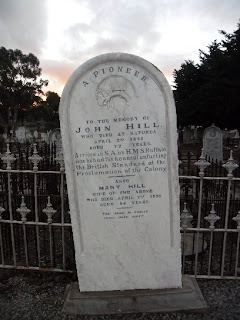
Researched and Written by Allen Tiller
for Kapunda Community Link
[1] The “Buffalo” was originally named The Hindostand in 1813 when it was built it was sold in that same year to the United Kingdom Navy and renamed “The Buffalo” where it began to ship mast timbers across the globe. It eventually was used to ship English female prisoners to Sydney (187) then travelled to South Africa. The ship was recommissioned in 1835 where it was fitted to house emigrants for transport to Australian Colonies.
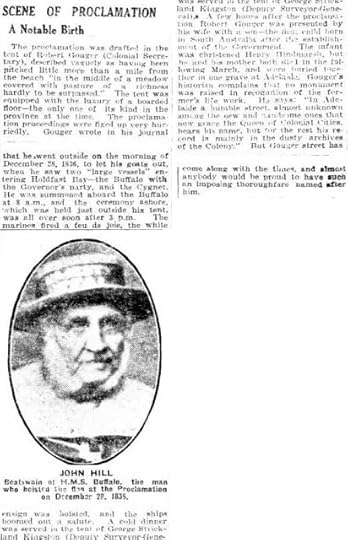
October 30, 2023
A Haunting at Melrose - St George’s Folly
The original owner, and builder, of the North Star Hotel at Melrose, was William St. George. The North Star Hotel was originally licenced in 1854, operating from a simple log hut. Such were the profits from his hotel, which allowed St George to build his mansion. The house featured cedar fittings throughout and was believed to be the first in South Australia to have a corrugated iron roof. Unfortunately, St. George never got to enjoy his home, as he was killed in an accident at Roseworthy.
St. George was carting furniture from Adelaide to George’s Knob, ten kilometres south of Melrose in the Flinders’ Ranges when his horses fell into an unseen railway ballast pit, toppling his cart and killing him. William St George was buried at Gawler Cemetery, which is now Pioneer Park in 1863.
His house became derelict and was frequented by squatters. A 1904 newspaper article in the Evening Journal detailed graffiti on the internal walls of the house, one stated ‘I can’t sleep here tonight; this great windy house seems to haunt a fellow.”[3]It became rumoured that the house was haunted. The Evening Journal claimed that “a party of superstitious people recently slept on the premises with loaded guns, but the ghost did not come that night.”[4]
Eventually, the property was purchased by J. H. Angus and became a part of the Willowie Pastoral Company. It was renovated and lived in by a pastoral overseer for the company John Ross and his wife Lyn. The house then became known as Rosslyn Estate.
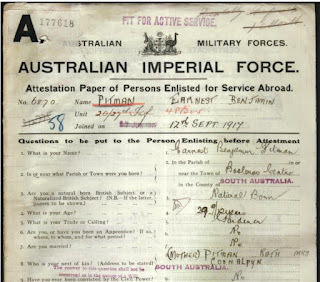
From the 1st of November 1920, the house was occupied by Ernest Benjamin Pitman.Pitman received the property from the Soldier Settlement Branch. Soldiers who were honourably discharged from Australia’s Imperial Forces and served overseas were entitled to assistance from the South Australian Government purchased land and assisted in erecting buildings, purchasing seeds and general improvements of the property.
In his book, Ghosts and Haunting of South Australia, author Gordon de L. Marshall interviewed Keith Pitman, son of Ernest. Keith stated that in the 1920s his father first witnessed a ghost. During daylight, the ghost came out from the cellar, it was a skeleton dressed in a shroud. According to Keith, his father was sitting near a window when he witnessed the ghost walk alongside the house, through a 3000-gallon water tank, and out to a paddock, some 400 meters from the house. There it stopped.
Ernest went and investigated the location and found the remnants of an old grave, but no headstone.
The family believed that another ghost haunted the old home, that of William St George. They believed St. George would open doors in the house. The family never felt uncomfortable around this ghost. Keith Pitman sold Rosslyn in 2002.
Researched and written by Allen Tiller © 2023
[1] North Star Hotel, Melrose Community Development Association, (2022), https://www.melrose-mtremarkable.org....
[2] 'MOUNT REMARKABLE', South Australian Register, (29 October 1863), p. 3.
[3] 'WHEN MELROSE WAS YOUNG.', Evening Journal, (29 September 1904), p. 2.
[4] Ibid.
[5] Ibid.
[6] ‘PITMAN Ernest Benjamin Hundred of Wongyarra, Sections 381/3 1 Nov 1920.’, GRG35/320 Record of land held by soldier settlers - Soldier Settlement Branch 1917-1931, State Archives of South Australia, vol 2, (2019), p. 83, https://archives.sa.gov.au/sites/defa....
[7] Gordon de L. Marshall, Ghosts and Haunting of South Australia, (2012), p. 214-15.
[8] Melrose land sale sets new record, The Flinders News, (2017), https://www.theflindersnews.com.au/st....
October 24, 2023
Old Goolwa Police Station and Court House
The Goolwa Police station was erected in 1859, It was designed by Colonial Architect E.A. Hamilton. The police station had its own water supply via a well. In 1867 a courthouse was erected next door, and in 1874 a sore for Aboriginals was built alongside it.
The Goolwa Police Station was closed in 1993 when a new purpose-built station was opened. At the time the Goolwa Police Station was the oldest operating police station in Australia.
Goolwa Radio Alex Fm run a local ghost tour every Halloween. That ghost tour takes in the old Goolwa Police Station and courthouse complex which is now the SA Coast Regional Arts Centre. During one of many tours, a person on the tour snapped a photograph of the front of the building which shows what looks to be a person looking out at them. It is claimed that no-one was inside the building at the time the photograph was taken.
“The photo below was taken on a previous Ghost Tour outside the Old Police Station. Witnesses at the event insist there was no one in the doorway when the photo was taken! The figure is thought to be that of a Police Constable who drowned at the Murray Mouth in 1880.”
– Radio Goolwa Alex FM
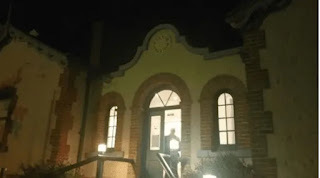
Researched and written by Allen Tiller © 2023
[1] Department for Environment and Heritage, ‘Police Station & Courthouse and Outbuildings’, Government of South Australia, (2012), https://cdn.environment.sa.gov.au/env....
[2] 'Force defends station', Times, (25 June 1993), p. 1.
[3] Goolwa Historic Ghost Walk’, Pet Let, (2021), https://petlet.net.au/goolwa-historic...
October 3, 2023
Gawler Station Signal box fire 2005
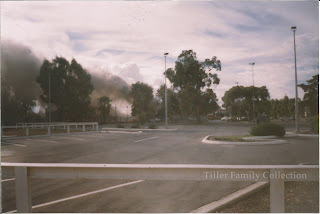
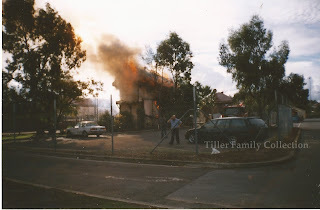
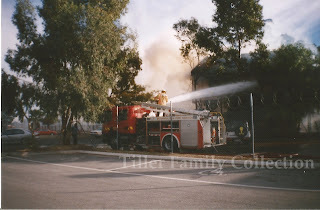
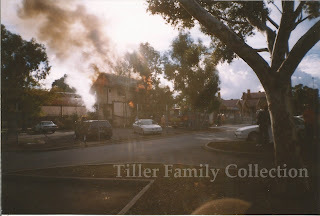
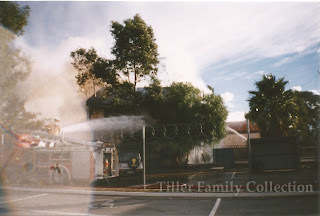
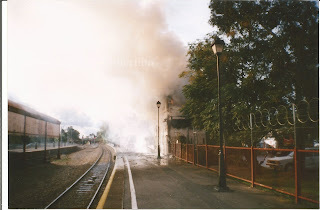
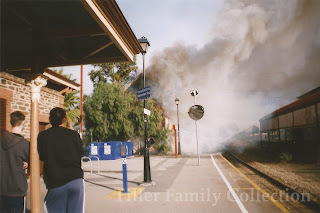
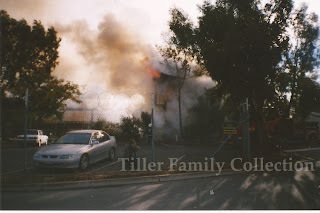
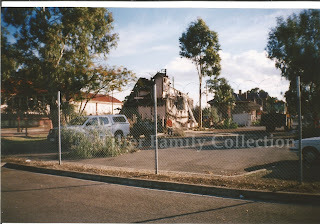
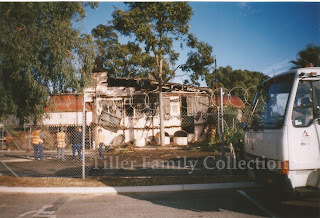
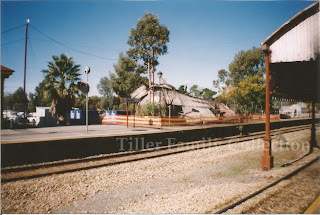
August 8, 2023
Caust's Angel
Caust's Angel
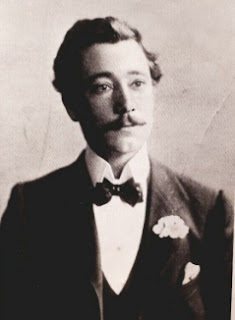
Charles Arnold Caust was born on August 11 1878 at Chain of Ponds in the Adelaide Hills. Caust’s family were devoted Methodists. He left the Adelaide Hills and for five years lived with his sister at Goodwood, and later Hindmarsh.
At age 19, Caust had a vision of an Angel. The Angel said to him “You will not live another ten years.”
Although he was not a superstitious man, the visitation made him uneasy.
Two years later the same angel appeared, saying the same thing. In the weeks before his death, Caust spoke to his wife and his brother Ray about the Angel vision, stating he was not troubled by it, as he believed it was God calling him to work.
William Strapps took his sons Claude and Frank, and Frank's friends Gordon Miller and Leslie Heming out for a sail in a canvas canoe at about 4pm. As the boat turned, it capsized, spilling all inside into the sea. Witnesses on the shore and jetty watched on as Claude Strapps swam to the shore, and the others struggled in the deep water.
Caust was sitting at Henley Beach on Saturday 8 January 1906, with his friends and family. A boat with five people aboard capsized a fair distance out. Caust, who was holding his child kissed her and said ‘God will help you if I fail. He handed his daughter to a friend, ran down to the water, stripped off and jumped into the sea. He swam towards the upturned canoe in heavy seas. Large waves tumbled him, but he struggled on. Another wave crashed over Caust, and he disappeared from sight. His wife, now standing on the shore watching, screamed in uncontrolled grief – her husband was gone…
The boys and their captain, nearing exhaustion were rescued by Stanley and Herbert Scrymgour. In a newspaper interview William Strapps called Caust ‘one of nature’s noblemen,’ and went on to state,
as being unacquainted with boats or with the sea he was unaware that we were in no immediate danger. Our craft is a good life raft when capsized, and none but swimmers are ever allowed aboard. The fact that he could not manage a boat, and was not an expert swimmer, only increases one's admiration of his futile efforts.
Causts body was found the following day at Grange Jetty.It had been nine and half years since the angel visited Caust, foretelling his death. He was buried at Hindmarsh cemetery.
A monument was also erected at Chain of Ponds in honour of Charles Caust on 15 December 1907. Between 200 to 300 people attended the dedication service. The monument is of Italian marble and is erected adjacent to the gate of the Methodist church.
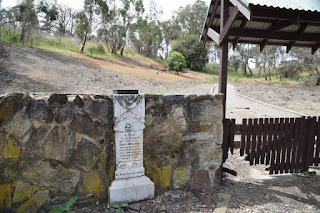
Front Inscription
A tribute to the heroism and self - sacrifice of - Charles Arnold Caust who was drowned on Jan 6th 1906, at Henley Beach while endeavouring to rescue others in peril
Aged 21 years.
He being dead yet speak.
In 2003, Chain of Ponds Winery in the Adelaide hills released a single vineyard shiraz called ‘The Ledge’ in honour of Charles Arnold Caust. You can find out more about it here: https://www.chainofponds.com.au/our-w...
Researched and written by Allen Tiller ©2023
[1] 'In Memoriam.', Australian Christian Commonwealth, (26 January 1906), p. 5.
[2] 'DROWNED AT HENLEY BEACH.', Chronicle, (13 January 1906), p. 39.
[3]'HENLEY BEACH DROWNING CASE.', The Age, (9 January 1906), p. 5.
[4] 'A MEMORIAL TO THE LATE CHARLES ARNOLD CAUST.', Australian Christian Commonwealth, (4 January 1907), p. 11.
[5] ‘Charles Arnold Caust’, Monument Australia, https://monumentaustralia.org.au/themes/people/tragedy/display/116440-charles-arnold-caust#:~:text=The%20monument%20commemorates%20Charles%20Arnold,Henley%20Beach%2C%20on%20Saturday%20afternoon.



